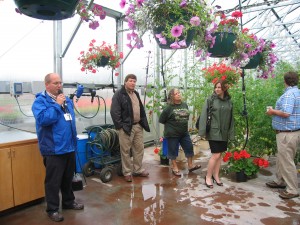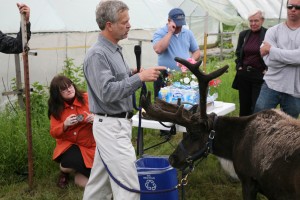Agriculture tour brings legislators to Experiment Farm
August 5, 2010
Guests, including Alaska lawmakers and their aides, were immersed in agriculture July
21 during a SNRAS/AFES farm tour. The theme of “Celebrate Alaska Agriculture” was
carried out in the food, demonstrations, and talks by agriculture experts.

The event began at Pike‚Äôs Waterfront Lodge with an almost entirely Alaska-grown meal, complete with steaks from the Matanuska Experiment Farm, potatoes from –‘”˚…Á research programs, squash from Jenny M Farms, lettuce from Chena Hot Springs Resort, tomatoes from Pike‚Äôs Tomato Greenhouse, cucumbers from –‘”˚…Á West Ridge Greenhouse and Pike‚Äôs Tomato Greenhouse, and rhubarb bread pudding. SNRAS Dean and AFES Director Carol Lewis told the audience, ‚ÄúThis is where food security begins.‚Äù She said –‘”˚…Á, as a land grant university, is part of American heritage that has helped the U.S. produce the highest quality food in the world. Lewis said when food is gone people will finally understand the real price of food.
After lunch, the group toured the Pike‚Äôs Tomato Greenhouse where SNRAS researchers work with FFA students and university students to grow cucumbers and tomatoes hydroponically. On the bus en route to the Fairbanks Experiment Farm, on the west edge of the –‘”˚…Á campus, Professor Steve Sparrow said the day had started backward, with the guests consuming the Alaska-grown food first and then seeing how it is grown. ‚ÄúWe‚Äôll do a full circle but we‚Äôll do it backward,‚Äù Sparrow said.He questioned the crowd, ‚ÄúWhat‚Äôs the big deal with food security?‚Äù Then he replied, ‚ÄúWe are extremely vulnerable concerning food.‚Äù If transportation systems were down Fairbanks would be in real trouble in a short amount of time.
The first stop was at Homegrown Market, where owner and livestock producer Jeff Johnson said he opened the shop out of frustration. “There was no outlet to sell meat,” he said. “I got sick to death of not selling my stuff.” Business in the small, tidy shop is good, according to Johnson. “I had 4,300 people in here last week.” The best sellers are beef, milk, and pork sausage. His next project is to add a smokehouse. “I’m paying my employees and my bills are paid so I’m happy with that,” Johnson said.
Back on the bus Dean Lewis said, ‚Äú–‘”˚…Á is not steeped in agriculture like most land grants.‚Äù In the 1930s and 1940s the university was an integral part of the community. By the 1950s when refrigeration was available it became cheaper to import food than to grow it. Driving by the West Ridge Greenhouse, Lewis said the old building can‚Äôt keep up with the education and outreach needs of the school and community. A new greenhouse is included in the general obligation bond package (House Bill 424) to be voted on this fall. The existing greenhouse, about fifty years old, is 3,500 square feet. The spot it is on is slated for the university‚Äôs new Life Sciences building, and a new greenhouse is being planned for construction adjacent to the Arctic Health Research Building. CES Director and –‘”˚…Á Vice Provost Fred Schlutt said he looks at the AFES greenhouse as part of community sustainability and food security, as well as energy. ‚ÄúIt‚Äôs a state issue,‚Äù he said.
At the Fairbanks Experiment Farm, Lewis told the visitors about the 250-acre research farm. “Much of the land is used to grow food for reindeer,” Professor Steve Sparrow said. Describing his work with biomass, he said, “A lot of what you hear about biomass is hype. We are looking at whether we can farm grasses and wood species feasibly for use as biomass.” Willows and poplars are in the test plots. Associate Professor Mingchu Zhang emphasized the three components of the experiment farm: “education, research, outreach.” He said barley, oats, wheat, canola, camelina, and sunflowers are tested at the farm. “We are developing technology for our farmers, determining what we can grow and how we can grow it best,” he said.
USDA Agricultural Research Service Researcher Steve Seefeldt outlined his work with weeds, such as quack grass, bird vetch, and pineapple weed. “Weeds are one of the consequences of farming,” he said. He is currently concentrating on chickweed, experimenting with seventeen different treatments. “I’m studying what happens to herbicides in frozen soils,” Seefeldt said. Professor Meriam Karlsson took the group though hoop houses. “We are adding new structures as technology has improved and changed,” she said. Hoop houses have been popular in Europe for many years but only the last ten in the U.S. “They get a lot of use in the summer and fall,” she said. Part of her research is how strawberries are sensitive to day length. “We are trying to get them to flower earlier and produce earlier,” she said. She is also working with six to eight varieties of potatoes, and growing horseradish, sugar beets, and popcorn.

A popular guest on the tour was Rip, a reindeer used by the Reindeer Research Program for outreach. Assistant Professor and RRP Program Manager Greg Finstad explained the meat science and nutrition research performed by RRP. “I believe in the product,” he said. “The meat is an amazing product. It is low-fat, low cholesterol, and has high mineral content.” But, Finstad cautioned, “If you don’t cook it right it tastes like liver.” He is working with culinary school at Kapiolani Community College in Hawaii to develop gourmet recipes using reindeer meat. “There is a huge demand for reindeer meat,” Finstad said. “We want to put reindeer meat in grocery stores and upscale restaurants in Alaska.”A new curriculum for high latitude range management at the Northwest Campus will help to build the industry, he said. “Reindeer mean food and jobs for Alaskans.”
The last stop on the tour was Rosie Creek Farm, where owner Mike Emers explained that his is the farthest north certified organic farm in the country. He serves 160 Community Supported Agriculture members and sells other crops to restaurants and at farm stands. “I market directly to the consumer,” he said. “The buy-local movement is catching on but it’s tough. We have to charge more for what we sell and we can’t compete with Food Service of America in price but I know my quality is better.” Surveying his land, he said, “It’s ridiculous that this is the largest vegetable farm in the area; we should have fifty more and we could be feeding Fairbanks.”
As the tour concluded, Rep. Jay Ramras who was a co-host with SNRAS and the Fairbanks Economic Development Corp., said, “I was fascinated with the reindeer discussion and I’m fascinated with growing food for volume so it contributes to food security. “It’s nice to see so many intelligent people pushing forward with these issues,” Ramras said. “And it was a darned good steak.”


